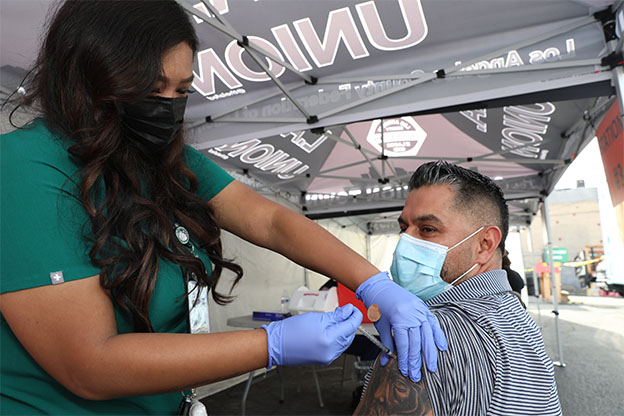The new Omicron wave of the pandemic Covid makes vaccination and safety more important than ever.
Following new guidelines will help to keep skilled construction workers safely on the job. “In 2020 and 2021, working together, we were able to keep construction sites open,” said Chris Hannan, Executive Secretary of the Los Angeles/Orange Counties Building and Construction Trades Council. “Our goal in 2022 is to keep our economy open and workers safe, by using all the tools we have available.”
For workers and families: Vaccination

*Vaccinate: Vaccinations are open to all people age 5 and above. Booster shots are recommended—a third dose after Moderna or Pfizer vaccine, or a second dose after Johnson & Johnson.
*Vaccinations and boosters are free.
*Same-day and walk-in vaccinations are easy to find.
*People who are vaccinated are less likely to get Covid. Vaccinated people who do get Covid are less likely to be hospitalized or to have long-term, serious symptoms.
*Where to get vaccinated:
LA County: http://publichealth.lacounty.gov/media/coronavirus/vaccine/resources.htm
Orange County: https://occovid19.ochealthinfo.com/covid-19-vaccine-resources
State of California: https://covid19.ca.gov/vaccines/
 For workers: workplace safety:
For workers: workplace safety:
- Don’t go to work if you have a fever.
- Don’t go to work if you have a cough or shortness of breath.
- Avoid contact with sick people.
- Don’t shake hands when greeting others.
- Avoid meetings of 10 people or more.
- Stay at least 6 feet away from others. If you must work closer, make sure you are well masked.
- Wear a mask at all times on site. Most worksites now require a surgical, N95 or KF94 mask. Cloth bandanas are NOT accepted as safety protection: https://calmatters.org/economy/2022/01/california-covid-rules/
- Cover your mouth and nose with tissues if you cough or sneeze or do so into your elbow.
- Avoid touching your eyes, nose or mouth with unwashed hands.
- Clean your hands often by washing them with soap and water for at least 20 seconds. When hand-washing isn’t available, use an alcohol-based hand sanitizer with greater than 60 percent ethanol or 70 percent isopropanol. Soap and water should be used if hands are visibly dirty.
- Clean your hands frequently, including before and after going to the bathroom, before eating, and after coughing, sneezing or blowing your nose.
- Bring food and water bottles from home to the job site and do not share.
For employers:
Construction industry employers should develop a comprehensive COVID-19 exposure control plan, which includes control measures, symptom checking, social distancing, hygiene and decontamination procedures, and training.
Training should cover the hazards and control measures including social distancing, vaccinating and masking.
- Identify choke points where workers are forced to stand together, such as hallways, hoists and elevators, break areas and buses, and control them so social distancing is maintained.
- Minimize interactions when picking up or delivering equipment or materials.
- Provide soap and running water whenever possible on all job sites for frequent hand-washing. Provide alcohol-based hand sanitizers with greater than 60% ethanol or 70% isopropanol as a backup only if providing running water is impossible.
- Clean and disinfect high-touch surfaces on job sites and in offices—such as shared tools, machines, vehicles and other equipment, handrails, doorknobs, and portable toilet —frequently, per CDC guidelines.
- If you work in health care facilities, train your workers in Infection Control Risk Assessment


 For workers: workplace safety:
For workers: workplace safety: